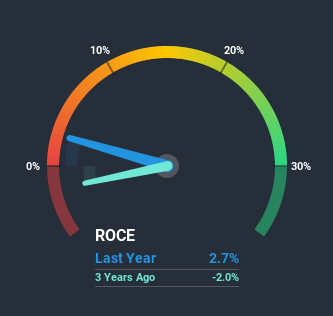Returns On Capital Tell Us A Lot About RigNet (NASDAQ:RNET)

When we're researching a company, it's sometimes hard to find the warning signs, but there are some financial metrics that can help spot trouble early. When we see a declining return on capital employed (ROCE) in conjunction with a declining base of capital employed, that's often how a mature business shows signs of aging. Trends like this ultimately mean the business is reducing its investments and also earning less on what it has invested. On that note, looking into RigNet (NASDAQ:RNET), we weren't too upbeat about how things were going.
Understanding Return On Capital Employed (ROCE)
For those that aren't sure what ROCE is, it measures the amount of pre-tax profits a company can generate from the capital employed in its business. The formula for this calculation on RigNet is:
Return on Capital Employed = Earnings Before Interest and Tax (EBIT) ÷ (Total Assets - Current Liabilities)
0.027 = US$4.2m ÷ (US$218m - US$61m) (Based on the trailing twelve months to June 2020).
Thus, RigNet has an ROCE of 2.7%. In absolute terms, that's a low return and it also under-performs the Energy Services industry average of 5.7%.
Check out our latest analysis for RigNet
Above you can see how the current ROCE for RigNet compares to its prior returns on capital, but there's only so much you can tell from the past. If you're interested, you can view the analysts predictions in our free report on analyst forecasts for the company.
What The Trend Of ROCE Can Tell Us
In terms of RigNet's historical ROCE trend, it isn't fantastic. The company used to generate 16% on its capital five years ago but it has since fallen noticeably. What's equally concerning is that the amount of capital deployed in the business has shrunk by 37% over that same period. The fact that both are shrinking is an indication that the business is going through some tough times. If these underlying trends continue, we wouldn't be too optimistic going forward.
While on the subject, we noticed that the ratio of current liabilities to total assets has risen to 28%, which has impacted the ROCE. Without this increase, it's likely that ROCE would be even lower than 2.7%. Keep an eye on this ratio, because the business could encounter some new risks if this metric gets too high.
The Bottom Line
In summary, it's unfortunate that RigNet is shrinking its capital base and also generating lower returns. We expect this has contributed to the stock plummeting 85% during the last five years. Unless these trends revert to a more positive trajectory, we would look elsewhere.
If you want to know some of the risks facing RigNet we've found 4 warning signs (1 is a bit concerning!) that you should be aware of before investing here.
While RigNet may not currently earn the highest returns, we've compiled a list of companies that currently earn more than 25% return on equity. Check out this free list here.
This article by Simply Wall St is general in nature. It does not constitute a recommendation to buy or sell any stock, and does not take account of your objectives, or your financial situation. We aim to bring you long-term focused analysis driven by fundamental data. Note that our analysis may not factor in the latest price-sensitive company announcements or qualitative material. Simply Wall St has no position in any stocks mentioned.
Have feedback on this article? Concerned about the content? Get in touch with us directly. Alternatively, email editorial-team@simplywallst.com.

 Yahoo News
Yahoo News 

